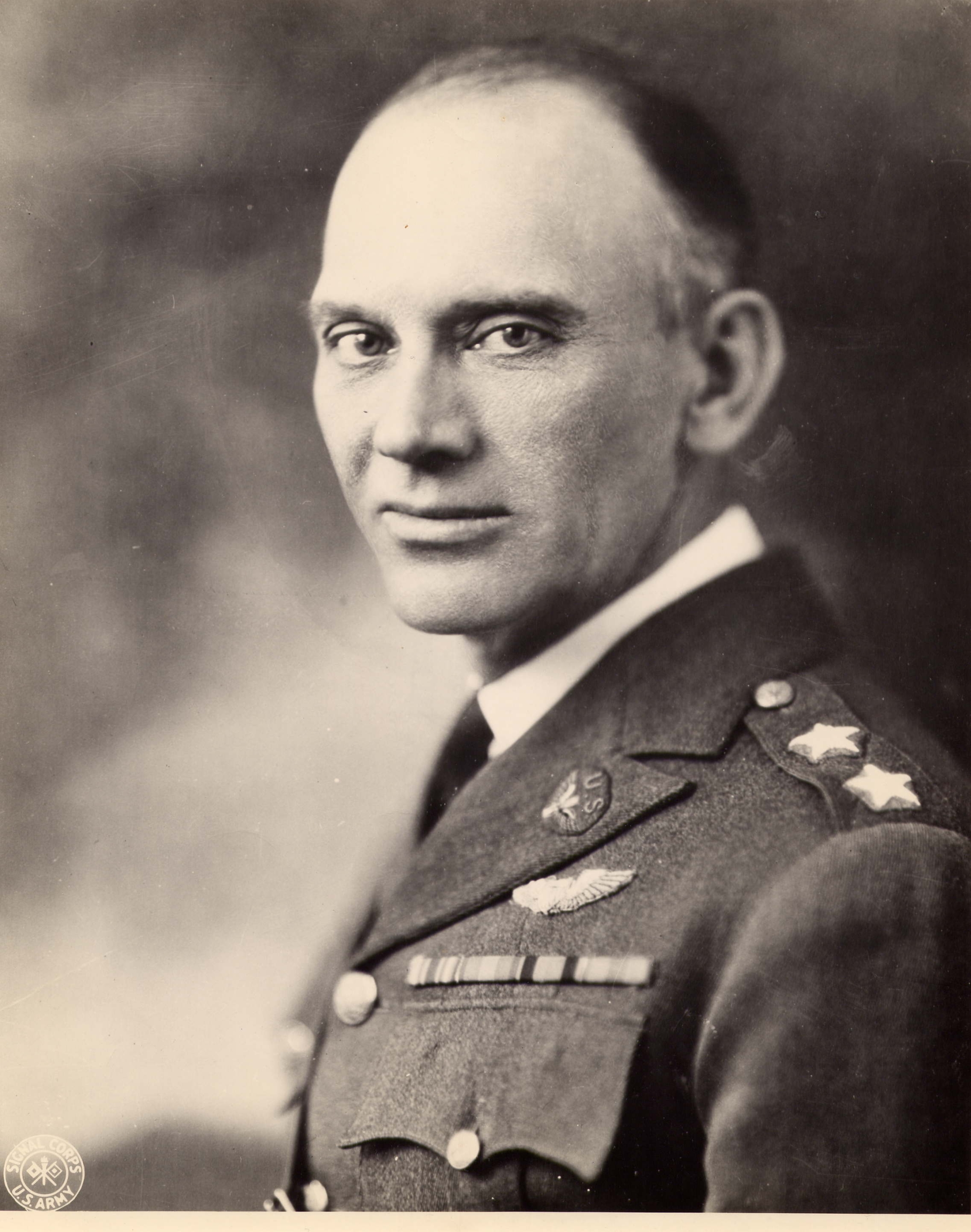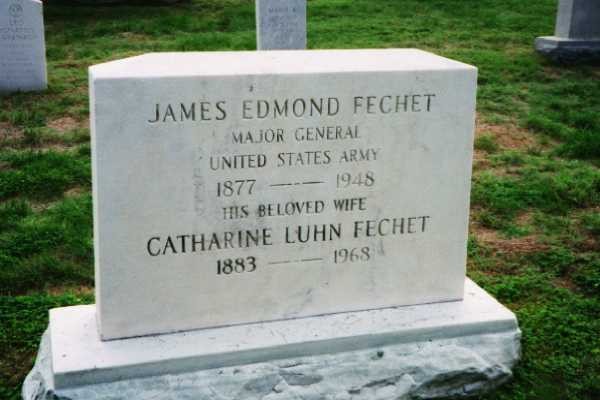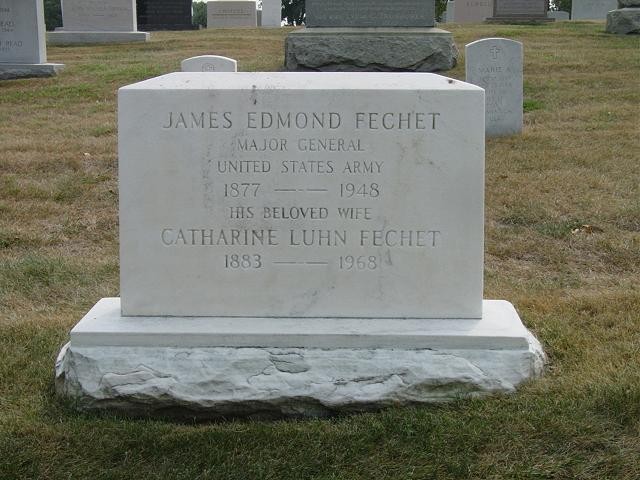Born at Fort Ringgold, Texas, August 21, 1877, he studied Mechanical Engineering for three years at the University of Nebraska and at the age of twenty enlisted in the United States Army Cavalry.
He served in Cuba during the Spanish-American War and got his commission in 1901 as a Second Lieutenant and went to the Philippines for duty against the Insurgents there.
In 1916, he went to Mexico with John J. Pershing’s Punitive Expedition and in 1917 got into aviation as Commanding Officer of the Signal Corps Flying School at Belleville, Illinois, and Arcadia, Florida. He personally advocated flying training and was in Washington, D.C. as Assistant Chief of the Air Service of the Army under Major General Mason Patrick. He moved up to Chief of the Air Service on December 12, 1927. With ten years of aviation experience behind him, he understood most of the problems and took action on them, such as establishing Randolph Field, Texas, as the “West Point of the Air” at a cost of $10 million.
He retired from the Army on December 10, 1931.
He died at Walter Reed Army Hospital, Washington, D.C., on February 10, 1948 and was buried in Section 3 of Arlington National Cemetery. His wife, Catherine Fechet (1883-1968), is buried with him.
Courtesy of the United States Air Force:
MAJOR GENERAL JAMES E. FECHET
Retired December 31, 1946, Died February 10, 1948
The chief of the Air Corps from 1927 to 1931, Major General James Edmond Fechet made a lasting mark on the nation’s air arm. Men he had selected and worked with both on his staff and in other top Air Corps positions became key leaders of the Air Forces in World War II – and they, in turn, have served with and have influenced today’s U.S. Air Force leaders.
Born at Fort Ringgold, Texas, in 1877, his military experience began with his youth as an Army Infantry officer’s son living at various frontier stations in the West. He left the University of Nebraska in 1898 in his third year as a mechanical engineering student to serve as an enlisted man in the Spanish-American War. He was wounded seriously at San Juan Hill in Cuba, but recovered and applied for a commission in the Cavalry. He was commissioned in 1900 and for the next six years served in many Cavalry assignments – in the western United States, in Hawaii, against the insurgents in the Philippines, and on the Punitive Expedition into Mexico.
Although he didn’t transfer from the Cavalry to the Air Service until 1920, Fechet, then a Lieutenant Colonel, served successively as commander of the Signal Corps Aviation School at Belleville, Illinois, in 1917; commander of the Aviation School at Arcadia, Fla., in 1918; and commander of Kelly Field, San Antonio. A few months later he was made Air Service Officer, Southern Department at Fort Sam Houston, Texas.
Except for 10 months as the commandant of the Advanced Flying School at Kelly Field in Texas, General Fechet spent the years from 1920 until he retired in December 1931 in the Office of the Chief of the Air Service. He was assistant chief of the Air Service for more than 2 1/2 years before becoming chief.
Fechet was near or at the top of the air arm’s leadership for more than a decade – during which the close-knit organization’s strength grew from 9,000 to 15,000. In the Cavalry he had been an outstanding equestrian, and for a time was on the U.S. Cavalry team. He learned to fly and to parachute as soon as he joined the air arm
although this was not required of officers entering in field grade. He said he learned to fly because he believed example to be essential to good leadership.
From General Fechet’s long and eventful experience as a commander in both the Cavalry and the fledgling air arm grew an attitude about military leadership and management that was adopted by top Air Force leaders in World War II who had been his protégés in the 1930s. “Take care of the little people and they’ll take care of you” was his dictum. He spent much time on the flight line, in the hangars and in the shops, and often inspected mess halls and warehouses. Morale of flyers and mechanics was to him as important a measurement factor for an operation as flying accident rates and engine failures. His concern for the welfare of personnel extended to career planning. He believed in sending to service schools those officers who showed promise – not those who could most easily be spared from duty. He had a faculty for remembering as individuals hundreds of enlisted men he had served with throughout his career and greeted them by name wherever he went in the Air Corps.
Being chief of the War Department’s air arm was particularly difficult in the years between World War I and Hitler’s rise in the mid-thirties. The government adhered to the Kellogg-Briand Pact renouncing war and endorsed the concept of limiting the strength of offensive forces. Moreover, the great military potential of airpower was not understood either by the general public or by many key officers in the ground forces.
Despite great handicaps, much of which stemmed from the air arm’s subordinate position in the War Department, the Air Corps progressed remarkably while General Fechet was Chief.
Under General Fechet the air arm grew from less than 1,000 aircraft to 1,700, organized into attack, bombardment, pursuit and observation squadrons. Big air maneuvers were organized in conjunction with the ground forces. The Air Corps was training group commanders, wing commanders and staffs for higher units.
The great flying center at San Antonio was established – “the West Point of the Air,” the Air Corps Training Center headquarters and site of the primary flying school.
The engineering and logistics center of the air arm, the Material Division, was established in its permanent home at Wright Field, Dayton, Ohio. It directed the work of other procurement and supply and maintenance operations in several states, linked by an air transport supply service.
The air arm was given the responsibility for land-based air defense of the coasts of the United States and the overseas possessions, an assignment increasing the Air Corps’ requirements for long range air capabilities.
Fechet encouraged work on the first experimental monoplane bomber that led to the twin-engine Boeing B-9, forerunner, along with the Martin B-10, of World War II bombers.
The Fechet era of the U.S. Air Force heritage was a time of record-breaking speed, distance and endurance flights as the interest in aviation – both military and civilian – was intensified by Charles E. Lindbergh’s inspiring flight.
In March 1942, 44 years after he had served as a sergeant in the Spanish-American War, the retired Air Corps chief of staff was recalled to help standardize the differing criteria for promotions and decorations in the various Air Force commands throughout the globe. He was director of the Promotion Board at Army Air Forces Headquarters with additional duty as president of the Pilot Allocation Board, Procurement Board and Decorations Board.
General Fechet retired for the last time four years later, on December 31, 1946, having served his country as few officers have – having seen the Air Force grow from three men to more than 2,300,000 – having helped airpower prove its promise.
He died in Walter Reed Hospital February 10, 1948 and was buried in Arlington National Cemetery.
FECHET, JAMES E
- MAJ GEN AIR CORPS USA RET
- DATE OF DEATH: 02/10/1948
- BURIED AT: SECTION 3 SITE 18227
ARLINGTON NATIONAL CEMETERY
FECHET, CATHERINE L WIDOW OF FECHET, JAMES E
- DATE OF BIRTH: 08/12/1883
- DATE OF DEATH: 02/09/1968
- BURIED AT: SECTION 3 SITE 1822 WN
ARLINGTON NATIONAL CEMETER
Michael Robert Patterson was born in Arlington and is the son of a former officer of the US Army. So it was no wonder that sooner or later his interests drew him to American history and especially to American military history. Many of his articles can be found on renowned portals like the New York Times, Washingtonpost or Wikipedia.
Reviewed by: Michael Howard



